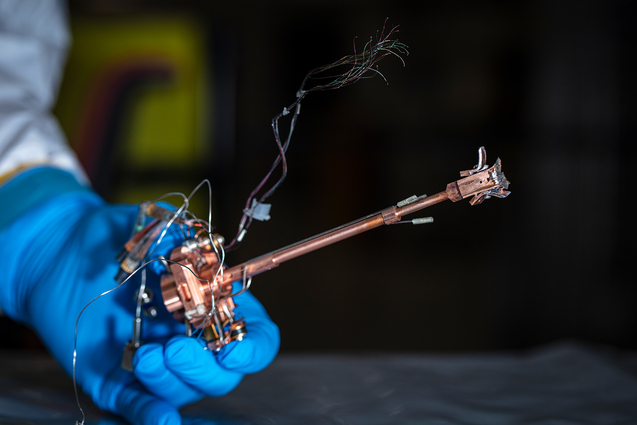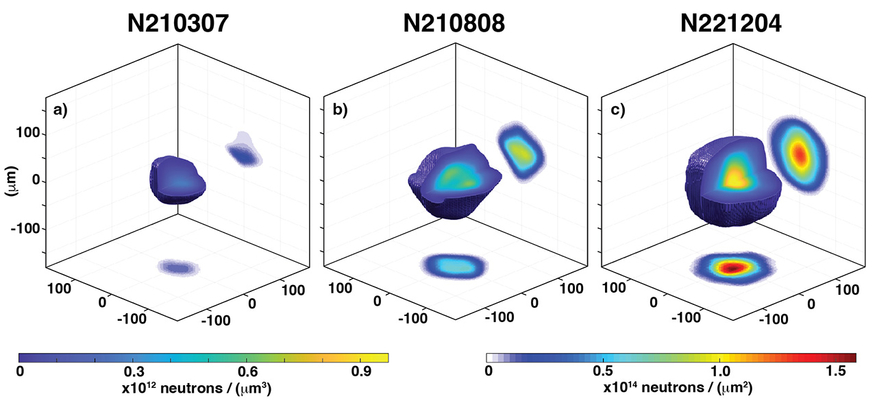LLNL’s breakthrough ignition experiment highlighted in Physical Review Letters
 (Download Image)
(Download Image)
The spent target assembly from LLNL’s first achievement on ignition on Dec. 5, 2022, which is reported in the cover article of the Feb. 5, 2024, issue of Physical Review Letters. (Photo: Jason Laurea/LLNL)
The details of Lawrence Livermore National Laboratory (LLNL)’s historic Dec. 5, 2022, experiment that achieved fusion ignition in a laboratory for the first time are presented in the cover article in the Feb. 5, 2024, issue of Physical Review Letters (PRL).
In the paper, researchers explain how, after a decade of overcoming challenges and working to improve the laser drive and optics, experimental design, computer modeling and target quality in dozens of experiments on LLNL’s National Ignition Facility (NIF), they finally succeeded in achieving “target gain” — producing more energy (3.15 megajoules) than the amount of laser energy delivered to the fusion target (2.05 MJ). That is the definition of ignition used by the National Academy of Science in a 1997 review of NIF.
The PRL paper, one of the first peer-reviewed publications describing the ignition experiment, was authored by more than 1,370 researchers from 44 international institutions who contributed over the decades to the remarkable scientific breakthrough. It is accompanied by companion papers in PRL and Physical Review E (PRE) providing further details about the physics theory, design, experimental advancements and target improvements that enabled the Dec. 5 shot to exceed the extreme conditions that exist in the center of stars and achieve ignition.
“The demonstrated level of target gain of 1.5 times was the first time that fusion target gain was unambiguously achieved in the laboratory in any fusion scheme,” the researchers said. “This achievement is the culmination of more than five decades of research and gives proof that controlled laboratory fusion energy, based on fundamental physics principles, is possible.”
The PRL paper traces the history of research into fusion, including the innovative 1972 proposal by former LLNL Director John Nuckolls and colleagues for an inertial confinement fusion (ICF) scheme using the radiative power of intense lasers to compress, heat and confine a reacting plasma.
The paper also enumerates the challenges the researchers faced in attempting to achieve the self-sustaining nuclear fusion that powers the sun and the stars, where gravitational forces provide the natural confinement, compression, and heating required for fusion. Other than at NIF, the world’s largest and highest-energy laser, these conditions occur on Earth only in an exploding thermonuclear weapon.
A primary goal of ignition is to help ensure the reliability and safety of the nation’s nuclear deterrent in the absence of underground weapons testing. A related LLNL mission is to enhance understanding of the requirements for developing inertial fusion energy as a safe, clean and virtually unlimited source of energy for the world.
Overcoming the challenges
“A fundamental obstacle to realizing a fusion energy source,” the researchers said, “has been the ability to control and heat a plasma (a mixture of ions and free electrons) to the conditions required for ignition and to confine the plasma at these conditions over long enough time scales such that more fusion energy is produced than was supplied to initiate the reaction.”
The research that led to LLNL’s success in overcoming this and many related challenges comprises the bulk of the PRL paper; a summary of that work can be found here and in this paper reviewing the history of the ICF program.
While the PRL paper focuses on the Dec. 5, 2022, ignition experiment, the researchers note that three subsequent experiments in 2023 also achieved target gain greater than one. An experiment on July 30 using 2.05 MJ of laser energy resulted in even more energy than the December experiment — 3.88 MJ, the highest yield achieved to date. On Oct. 8, NIF achieved fusion ignition for the third time with 1.9 MJ of laser energy resulting in 2.4 MJ of fusion energy yield.
And on Oct. 30, NIF set a new record for laser energy delivered, firing 2.2 MJ of energy for the first time on an ignition target, building on a capability first tested in 2018. This experiment resulted in 3.4 MJ of fusion energy yield. These results demonstrate that NIF can repeatedly conduct fusion experiments at multi-megajoule levels.
The researchers envisage additional improvements in NIF’s yield by further increasing the laser energy and improving hohlraum efficiency to drive larger targets and by optimizing drive and capsule dopant profiles.
They also acknowledged that the energy produced by the fusion reaction is far less than the energy required to fire the facility’s 192 powerful laser beams. Target gain greater than unity “does not imply net energy gain from a practical fusion energy perspective,” they said, “because the energy consumed by the NIF laser facility is typically 100 times larger” than the laser energy delivered to the target.
“The NIF laser architecture and target configuration was chosen to give the highest probability for fusion ignition for research purposes and was not optimized to produce net energy for fusion energy applications,” they said. “Inertial fusion energy applications requiring advancements to the underlying scheme require further development, such as laser energy usage, shot rate, target robustness, higher fuel compression levels and cost.”
In the wake of the repeated ignition success at NIF, LLNL is now developing an IFE Institutional Initiative to explore those requirements. In December, the Laboratory was named by the U.S. Department of Energy to lead the IFE Science and Technology Accelerated Research for Fusion Innovation and Reactor Engineering (STARFIRE) Hub, a four-year, $16-million project to accelerate IFE science and technology.
Here are summaries of the other PRL and PRE papers, all led by Laboratory authors:
- “Energy principles of scientific breakeven in an inertial fusion experiment,” by ICF chief scientist Omar Hurricane and colleagues. The paper, which was selected as a PRL Editors' Suggestion, reports on the physics principles of the design changes that led to the first NIF controlled fusion experiment to produce target gain greater than unity, or “scientific breakeven.”
- “Design of the first fusion experiment to achieve target energy gain > 1,” by Annie Kritcher, the Dec. 5 experiment’s lead designer and team lead for integrated modeling, and colleagues. This PRE paper describes how early NIF experiments were impacted by increased target defects that seeded hydrodynamic instabilities or unintentional low-mode asymmetries from non-uniformities in the target or laser delivery, which led to reduced fusion yields of less than one MJ.
- “Observations and properties of the first laboratory fusion experiment to exceed target gain of 1,” by Art Pak, team lead for stagnation science, Alex Zylstra, the Dec. 5 shot’s principal experimentalist and colleagues. This PRE paper describes the experimental evidence for the increased drive on the capsule using additional laser energy and control over known degradation mechanisms, which are critical to achieving high performance..
- “Hohlraum reheating from burning NIF implosions,” by Michael Rubery, lead experimentalist, and Mordy Rosen, lead designer/analyst and colleagues. This paper, also a PRL Editor’s Suggestion, describes, for the first time, reheating of ICF drive hohlraums by the rapidly expanding burning capsule stagnating upon its own previously ablated material and radiating X rays.
–Charlie Osolin
Contact
 Paul Rhien
Paul Rhien
[email protected]
(925) 422-4206
Related Links
Physical Review Letters ArticleNational Ignition Facility
Threshold of Ignition
History of research into fusion
Help ensure the reliability and safety
Inertial fusion energy
LLNL’s success
Fusion Breakthrough
ICF Program
Record Laser Energy
Building on a capability first tested in 2018
Energy principles of scientific breakeven in an inertial fusion experiment
Design of the first fusion experiment to achieve target energy gain > 1
Observations and properties of the first laboratory fusion experiment to exceed target gain of 1
Hohlraum reheating from burning NIF implosions






